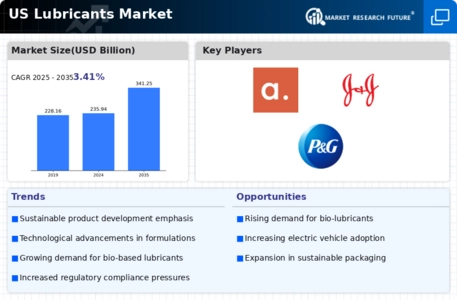Market Trends and Projections
The Global US Lubricants Market Industry is characterized by various trends and projections that illustrate its dynamic nature. The market is expected to grow from 235.94 USD Billion in 2024 to 341.25 USD Billion by 2035, indicating a robust growth trajectory. The compound annual growth rate of 3.41% from 2025 to 2035 highlights the increasing demand for lubricants across multiple sectors. Factors such as technological advancements, regulatory changes, and shifts in consumer preferences are likely to influence market dynamics. This chart provides a visual representation of the projected growth and trends within the Global US Lubricants Market Industry.
Growth in Renewable Energy Sector
The Global US Lubricants Market Industry is witnessing growth due to the expansion of the renewable energy sector. As the demand for renewable energy sources, such as wind and solar, increases, the need for specialized lubricants to maintain and operate renewable energy equipment becomes critical. These lubricants are essential for ensuring the efficiency and longevity of machinery used in energy generation. The anticipated market growth to 341.25 USD Billion by 2035 reflects the potential for lubricants tailored for renewable energy applications. This trend indicates a diversification of lubricant applications, positioning the Global US Lubricants Market Industry to adapt to evolving energy landscapes.
Rising Demand for Automotive Lubricants
The Global US Lubricants Market Industry is experiencing a notable increase in demand for automotive lubricants, driven by the growing automotive sector. As vehicle production continues to rise, the need for high-performance lubricants that enhance engine efficiency and longevity becomes paramount. In 2024, the market is projected to reach 235.94 USD Billion, reflecting the importance of lubricants in maintaining vehicle performance. Furthermore, advancements in lubricant formulations, such as synthetic oils, are likely to contribute to this growth. The automotive sector's shift towards electric vehicles may also influence lubricant requirements, indicating a dynamic landscape for the Global US Lubricants Market Industry.
Industrial Growth and Manufacturing Activities
The Global US Lubricants Market Industry benefits from the expansion of industrial activities and manufacturing processes. As industries such as construction, mining, and manufacturing grow, the demand for lubricants that ensure machinery efficiency and reduce wear and tear increases. The projected growth of the market to 341.25 USD Billion by 2035 suggests a robust correlation between industrial output and lubricant consumption. Additionally, the adoption of advanced lubrication technologies, including bio-based and high-performance lubricants, is likely to enhance operational efficiencies across various sectors. This trend underscores the critical role of lubricants in supporting industrial productivity within the Global US Lubricants Market Industry.
Regulatory Compliance and Environmental Concerns
The Global US Lubricants Market Industry is increasingly influenced by regulatory compliance and environmental concerns. Stricter regulations regarding emissions and waste disposal are prompting manufacturers to develop lubricants that meet these standards. This shift towards environmentally friendly products is not only a response to regulatory pressures but also reflects changing consumer preferences for sustainable options. The market's growth trajectory, projected to reach 341.25 USD Billion by 2035, suggests that companies investing in eco-friendly lubricants may gain a competitive edge. Furthermore, the emphasis on reducing the environmental impact of lubricants is likely to drive innovation and research within the Global US Lubricants Market Industry.
Technological Advancements in Lubricant Formulations
Technological innovations in lubricant formulations are a key driver for the Global US Lubricants Market Industry. The development of synthetic and semi-synthetic lubricants offers superior performance characteristics, such as enhanced thermal stability and reduced friction. These advancements are particularly relevant in high-performance applications, including automotive and industrial machinery. As the market evolves, the introduction of eco-friendly lubricants is also gaining traction, aligning with global sustainability goals. The anticipated compound annual growth rate of 3.41% from 2025 to 2035 indicates a growing acceptance of these advanced formulations, which are likely to reshape consumer preferences and industry standards in the Global US Lubricants Market Industry.














Leave a Comment